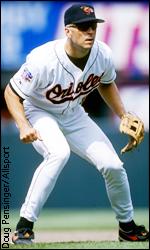 |
|
| | Thursday, December 30 | |||||
Special to ESPN.com | ||||||
Cal Ripken entered the Orioles clubhouse on July 1, 1982, looked at the lineup and saw a "6" next to his name, not a "5." No big deal, he thought, he just took more ground balls before the game at shortstop than at third base, his regular position.
No big deal, said Orioles manager Earl Weaver. It wasn't necessarily a career switch, just another experiment, a way to generate more offense, to get Floyd Rayford in the lineup at third base and to get disappointing Bob Bonner out of the lineup.
The move turned out to be a very big deal, indeed. Ripken played the next 2,216 games at shortstop, won the Rookie of the Year, two MVP awards and one World Series at that position. He also helped, along with Robin Yount, to change the dynamics of the shortstop, transforming it from a spot for good-field, weak-hitting guys (like Bob Bonner) to what it is today: A position for big, athletic, offensive and defensive players. It has become a position of the stars. Weaver had always considered using Ripken at shortstop because Weaver always loved offense, especially at non-power positions. He was always looking for a catcher who could hit three-run homers (OK, he was wrong about Earl Williams). Late in spring training in 1978, Weaver made a dramatic switch to get more offense, moving DH Lee May to first base, first baseman Eddie Murray to third base and third baseman Doug DeCinces to second. That lasted only a few games of the regular season because it was a disaster, especially defensively. Murray was returned to his rightful spot, as was DeCinces. It was somewhat risky moving someone as big and as young as Ripken to such an important defensive position, but that was Weaver's greatest attribute as a manager, his fearlessness. Plus, Ripken was drafted as a shortstop out of high school and played his first full season in the minor leagues (1978) there; he'd also started nine games there for Weaver in 1981. Third base might have been Ripken's best position, but shortstop was his favorite. It was clear to the Orioles that he could handle the responsibilities that go with the middle of the diamond. He did. And he was better defensively, from his first game to his last, than anyone had imagined. In 1984, he recorded 583 assists, the sixth-highest total ever for a shortstop. But what made the switch so successful and so important was his offense. For 15 years, he averaged 23 homers and 91 RBI at a position that historically hadn't even produced half of that. From 1971-81, only two shortstops, Roy Smalley and Toby Harrah, hit 19 homers in a season. Ripken hit at least 21 homers every season from 1982 through 1991. Yount won the MVP at shortstop in 1982, Ripken won it in '83 and before long, teams were looking for offense at the position. The Indians were soon starting Julio Franco at shortstop, sacrificing a little defense for a guy who could hit .300 with 80 RBI. And with Ripken's success, Detroit's Alan Trammell began his transformation from solid defensive player to one of the league's best hitters, the guy who should've won the '87 AL MVP. In Little Leagues and high schools across America, teenagers were taking notice of the change. A big kid from Florida named Chipper Jones grew up idolizing Ripken, wanting to be just like him -- and he might have except for a crushing knee injury in spring training of 1994 that forced a position change from shortstop to third base. A big kid from New York named Alex Rodriguez also grew up in Florida admiring Ripken, a shortstop who could hit in the middle of the order. And now, 17 years after Weaver made that switch, Ripken joined Honus Wagner as the shortstops on Major League Baseball's All-Century team. The honor was deserved, as not only did Ripken win Gold Gloves and set fielding records at shortstop, but he hit more home runs (345) and had more extra base hits (855) than any shortstop in major league history. Twenty years from now, however, Ripken might only be regarded as one of the top five shortstops in history. Rodriguez has 148 career homers before turning 25, and has already had a season (1996) that was better than any by a shortstop in history. Nomar Garciaparra has already become the only shortstop in history to hit 30 homers and drive in 100 runs in each of his first two major league seasons; last year, his third, he led the league in hitting (.357), joining Rodriguez as the only AL shortstops since World War II to do so. Derek Jeter is a lifetime .318 hitter, has been brilliant defensively and has three World Series rings in his first four years. Now there are big, strong, athletic kids all over America who want to grow up to be like Rodriguez, Jeter and Garciaparra. And some of that credit goes to Weaver for having the courage to make a switch in midseason, and to Ripken for having the ability to make it work.
ESPN The Magazine's Tim Kurkjian is a regular contributor to ESPN.com. | ALSO SEE ESPN.com's 10 key coaching decisions Message Board  | |||||


